UAE LIVE Population Count
11,137,155
The UAE, recognized as one of the safest countries in the world, has witnessed a steady rise in its population over the years.
This growth is not merely a result of safety but a combination of factors, including its open-border-for-work policy, expat-friendly laws, and a wealth of professional opportunities.
Today, the UAE is a melting pot of cultures, hosting people from over 200 different nationalities.
With an array of development plans in the pipeline, ranging from infrastructure developments to renewable and nuclear energy generation, the country’s future appears promising.
More people are expected to relocate to the UAE drawn by the opportunities it offers.
Now, let’s delve into the ‘UAE Population Statistics 2024’ and see what demographic changes have occurred in 2024.
UAE Population 2024 (Key Statistics)
According to statista, the population of UAE in 2024 is 10.24 Million.
According to the official statistics by the Dubai Government, the Dubai population stands at 3.68 Million as of April 2024.
According to the research done by GMI, the total Expat population in UAE in 2024 stands at 9.06 Million.
The total male population in UAE 2024 is 7.07 Million.
The total female population in UAE 2024 is 3.17 Million.
As of April 2024, the Indian population in UAE is 3.91 Million.
The largest age bracket in the UAE’s population falls between 25 to 54 years, making up 7.03 million people.
In 2024, the urban population of the UAE stands at 9.00 million, while the rural population constitutes 1.24 million people.
The median age of the population in the UAE is 33.6.
The population density in the UAE (people per sq. km) is 134.5.
The History
The UAE began its journey from the treaty between the British and the Emirates in the 19th century.
The coalition of the Emirates was called the “Trucial States”.
Once the Trucial State was liberated from the British treaty, the UAE was born.
In 1950, the population of UAE was just 70,000 but with the discovery of oil in the late 1950s a huge economic and social transformation began.
As infrastructural activities began in full swing, the need for foreign labour increased.
Since then, the UAE has seen a huge number of people trickling in to gain from the profitable economic bustle including trade, real estate, construction etc.
Now let us probe into the population statistics and try to understand it clearly.
United Arab Emirates – Country Profile
The United Arab Emirates (UAE), formerly the Trucial States, is located at the eastern end of the Arabian Peninsula.
It is a federation of seven emirates: Abu Dhabi (capital), Dubai, Sharjah, Ajman, Umm Al Quwain, Ras Al Khaimah, and Fujairah.
The country spans an area of 83,600 km2 and heavily relies on its oil sector.
The UAE runs as a federation with a single advisory body, The Federation Supreme Council.
At present, the president of the council is Sheikh Mohamed bin Zayed Al Nahyan.
Sheikh Mansour Bin Zayed Al Nahyan has been appointed as the UAE Vice-President with the approval of the UAE Federal Supreme Council.
Concurrently, the incumbent Vice President, Sheikh Mohammed Bin Rashid Al Maktoum, will continue in his current role.
The official language here is Arabic, the official religion is Islam, and the currency used here is the dirham.
UAE Population 2024 (Infographics)

Demographics of UAE in 2024
According to our 2024 data study, the demographic data of the UAE can be classified into:
Gender Split
Gender | Population | Percentage |
Male | 7.07 Million | 69.01% |
Female | 3.17 Million | 30.99% |
In the UAE’s population breakdown by gender, men make up 7.07 million while women account for 3.17 million.
The gender distribution shown above results from many factors, including family dynamics, education, job scenarios, etc.
However, this balance can shift as society, economics and policy over time.
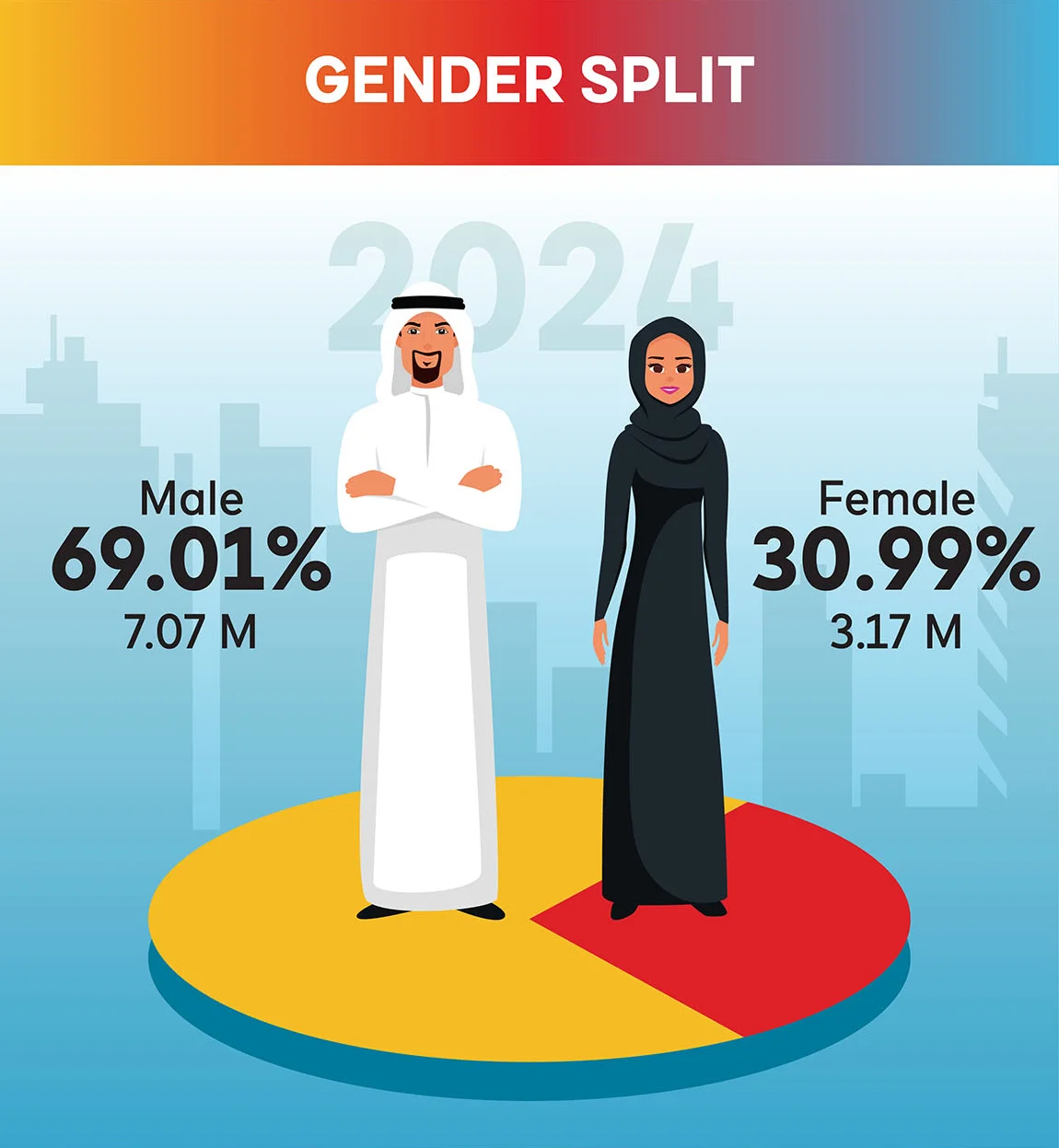
UAE Population by Age
Age Group | Population | Percentage |
0-14 years | 1.55 Million | 15.12% |
15-24 years | 0.94 Million | 9.14% |
25-54 years | 7.03 Million | 68.62% |
55-64 years | 0.53 Million | 5.21% |
65 years and over | 0.20 Million | 1.92% |
The population distribution across various age groups in the UAE demonstrates a notable concentration within the 25 to 54 years range.
It constitutes the largest portion at 68.62%, equivalent to approximately 7.03 million people.
The younger demographic, aged 0-14 years, accounts for 15.12%, totalling approximately 1.55 million individuals.
The age group of 15-24 years represents 9.14% of the population, comprising about 0.94 million people.
Notably smaller but still significant, the 55-64 years group comprises 5.21% of the population, amounting to approximately 0.53 million individuals.
The older demographic, aged 65 years and over, constitutes 1.92% of the population, totalling around 0.20 million people, reflecting a relatively smaller yet distinct part of the population in the UAE.
The age distribution of the UAE in 2024 clearly shows that the population mainly consists of working-class individuals.
This shows that the UAE is a booming economy with many growth opportunities.
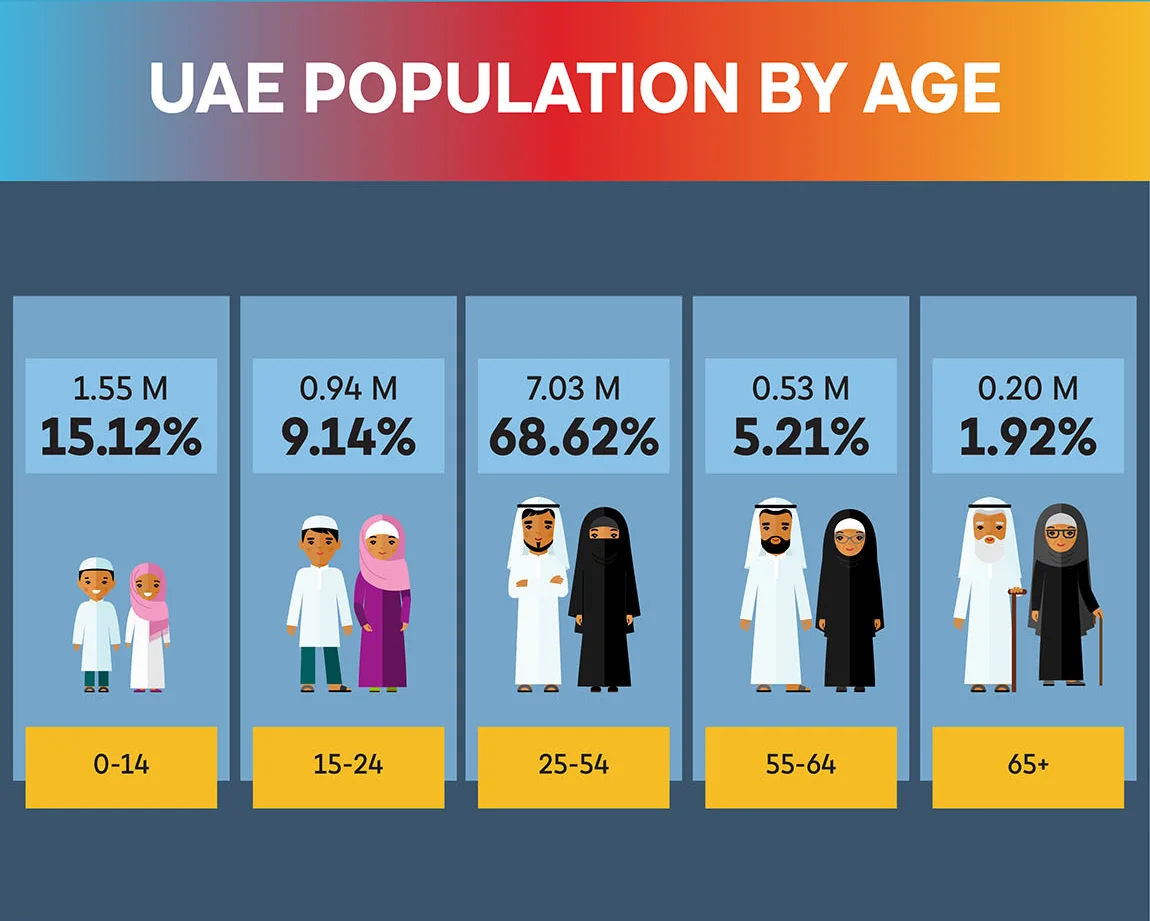
UAE Population by Gender
Age Group | Men Population | Women Population |
0-14 years | 0.80 Million | 0.75 Million |
15-24 years | 0.56 Million | 0.38 Million |
25-54 years | 5.22 Million | 1.81 Million |
55-64 years | 0.38 Million | 0.15 Million |
65 years and over | 0.11 Million | 0.09 Million |
Looking into specific age groups, within the 0-14 year bracket, there are 0.80 million boys and 0.75 million girls.
In the 15-24 years range, the male population is 0.56 million, while females are 0.38 million.
Notably, between 25 and 54 years, the male population is 5.22 million, whereas women in the same age range total 1.81 million.
In the 55-64 years age range, there are 0.38 million men compared to 0.15 million women.
Finally, for individuals aged 65 years and older, men account for 0.11 million, slightly outnumbering women at 0.09 million in this age category.
The gender distribution shown above results from many factors, including family dynamics, education, job scenarios, etc.
However, this balance can shift as society, economics and policy over time.
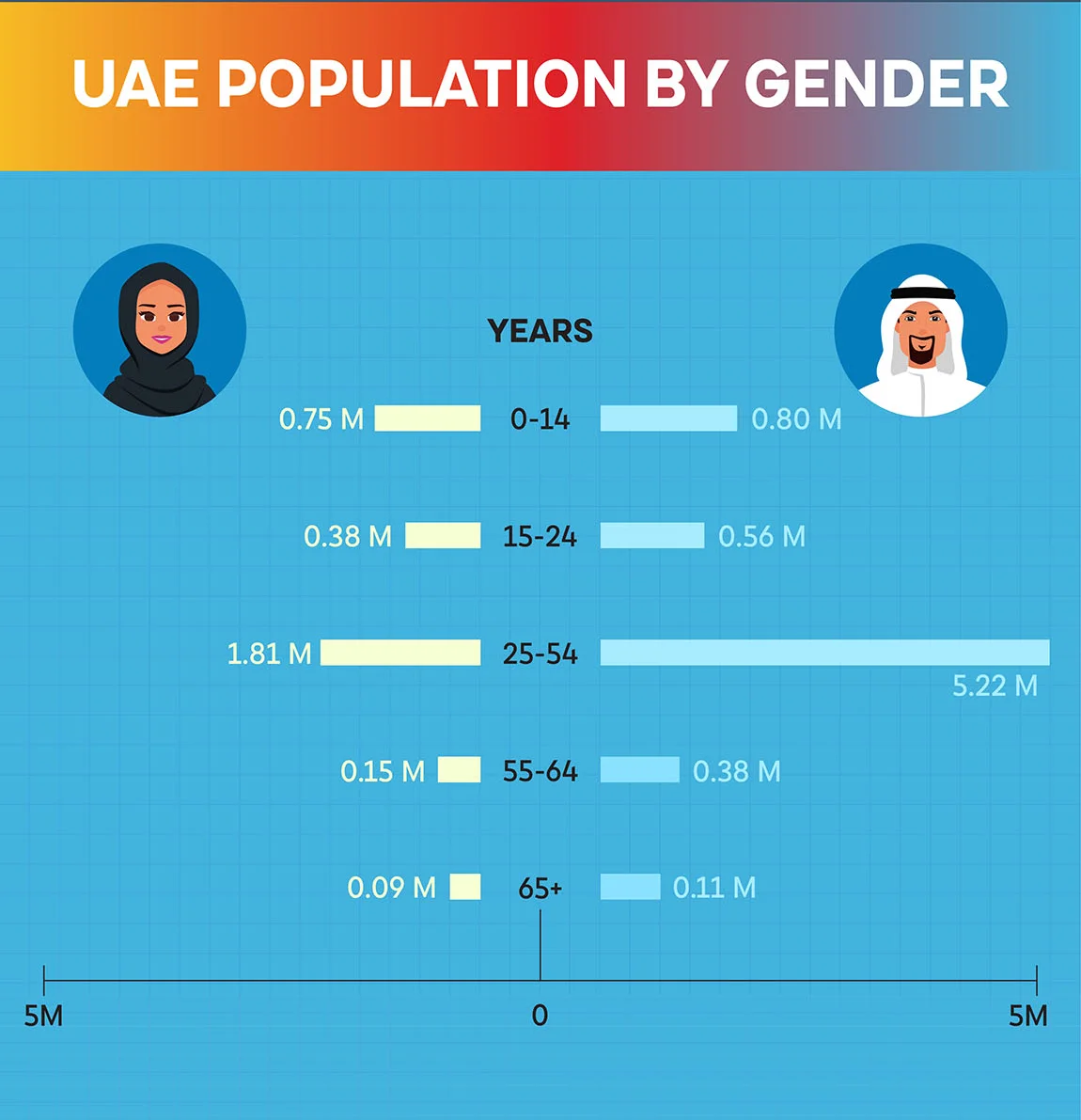
UAE Population by Emirates
Location | Population |
Dubai | 3,681,463 |
Sharjah | 1,872,000 |
Abu Dhabi | 1,593,000 |
Ajman | 504,846 |
Ras al-Khaimah | 345,000 |
Fujairah | 256,256 |
Umm Al Quwain | 49,159 |
The population distribution among the Emirates in the UAE illustrates a clear dominance of areas such as Dubai, housing 3,681,463 individuals, and Sharjah with 1,872,000 residents.
Abu Dhabi follows closely with a population of 1,593,000, showcasing a considerable concentration of residents as well.
In contrast, the remaining Emirates exhibit smaller population sizes, with Ajman totalling 504,846 inhabitants, and Ras al-Khaimah at 345,000.
Al Fujayrah has 256,256 residents, and Umm al Qaywayn has the smallest population at 49,159.
Various factors like economic opportunities, cultural attractions, and infrastructure development all contribute to the different population sizes among the emirates.
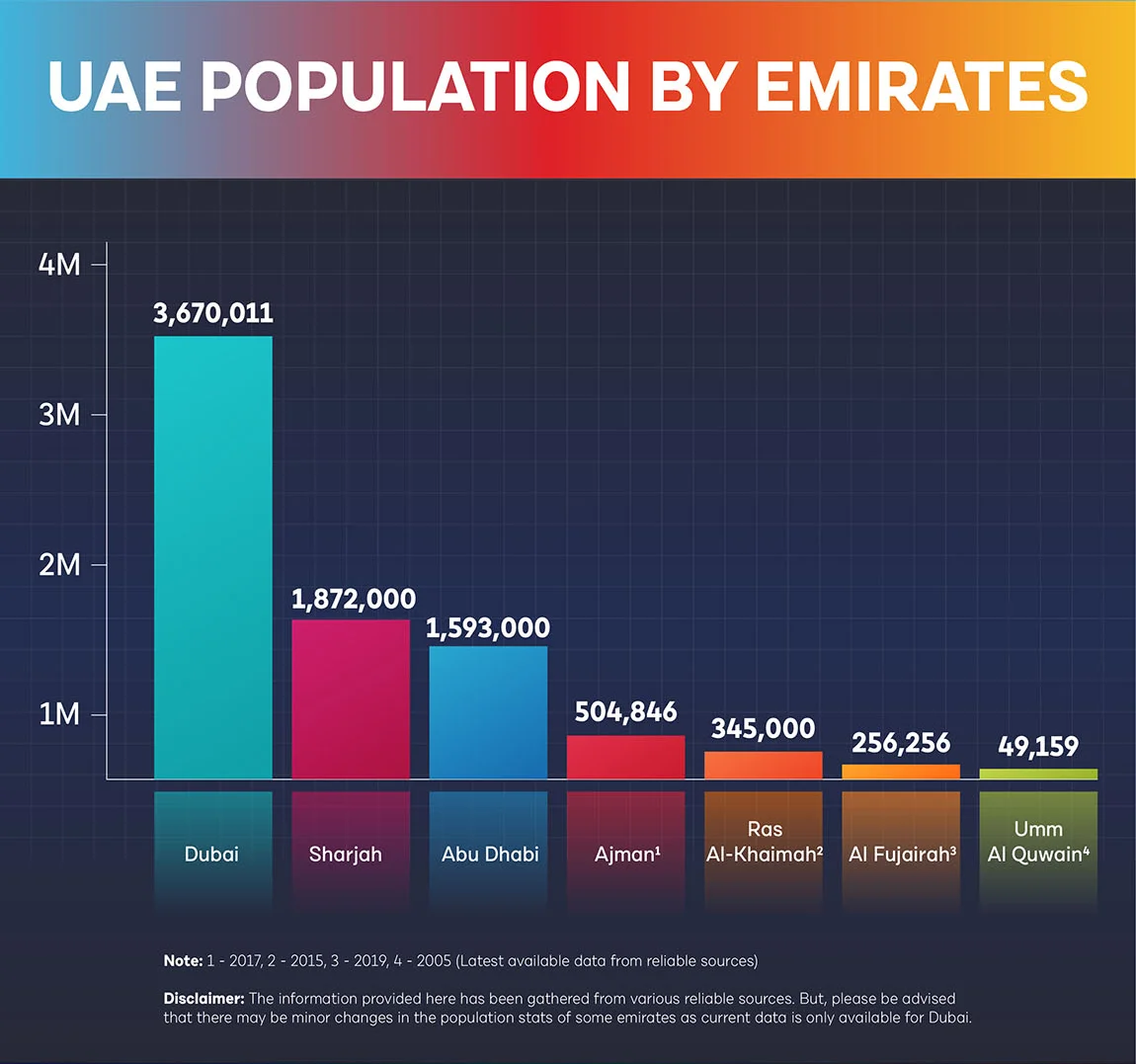
Emirati Vs Expatriates
Nationality | Population | Percentage |
Emirati | 1.18 Million | 11.50% |
Expat | 9.06 Million | 88.50% |
The expat population in the UAE stands at 9.06 million, significantly larger than the Emirati population, which totals 1.18 million.
Expat residents constitute approximately 88.50% of the population, while Emiratis make up around 11.50%.
In the above context, the government is taking steps to help increase the Emirates population.
For example, the Dubai Social Agenda 33 aims to increase the number of Emirati families by 2033.
The agenda also aims to provide more jobs to Emiratis in the private sector.
UAE Population by Nationality 2024
Nationality | Population | Percentage |
India | 3.91 Million | 38.20% |
Bangladesh | 0.97 Million | 9.50% |
Pakistan | 0.96 Million | 9.40% |
Other South Asians | 0.24 Million | 2.30% |
Egypt | 1.04 Million | 10.20% |
Philippines | 0.62 Million | 6.10% |
All other countries | 1.31 Million | 12.80% |
Total Expat Population | 9.06 Million | 88.50% |
The UAE is home to 9.06 million expatriates, comprising 88.50% of its total population.
The largest expat community hails from India, with 3.91 million people, representing 38.20% of the expat population.
Bangladesh and Pakistan also have significant representation in the UAE, with 0.97 million and 0.96 million people respectively, among the South Asian countries.
Several other South Asian countries collectively contribute an additional 0.24 million people, making up 2.30% of the expat population.
Egypt also has a substantial presence in the UAE, with 1.04 million people, or 10.20% of the expat population.
The population representation from the Philippines is also notable, with 0.62 million individuals, accounting for 6.10% of the total expatriate population.
The remaining 1.31 million expatriates hail from various other countries, further contributing to the UAE’s multicultural demographic.
UAE Population 2024 (Urban vs Rural)
Urban | 9.00 Million | 87.90% |
Rural | 1.24 Million | 12.10% |
The statistics depict a significant urban-centric demographic in the UAE, with 87.90% (9.00 million) of the population residing in urban areas and only 12.10% (1.24 million) in rural areas.
With improved access to healthcare, education, and job opportunities, people prefer settling in urban areas in 2024.
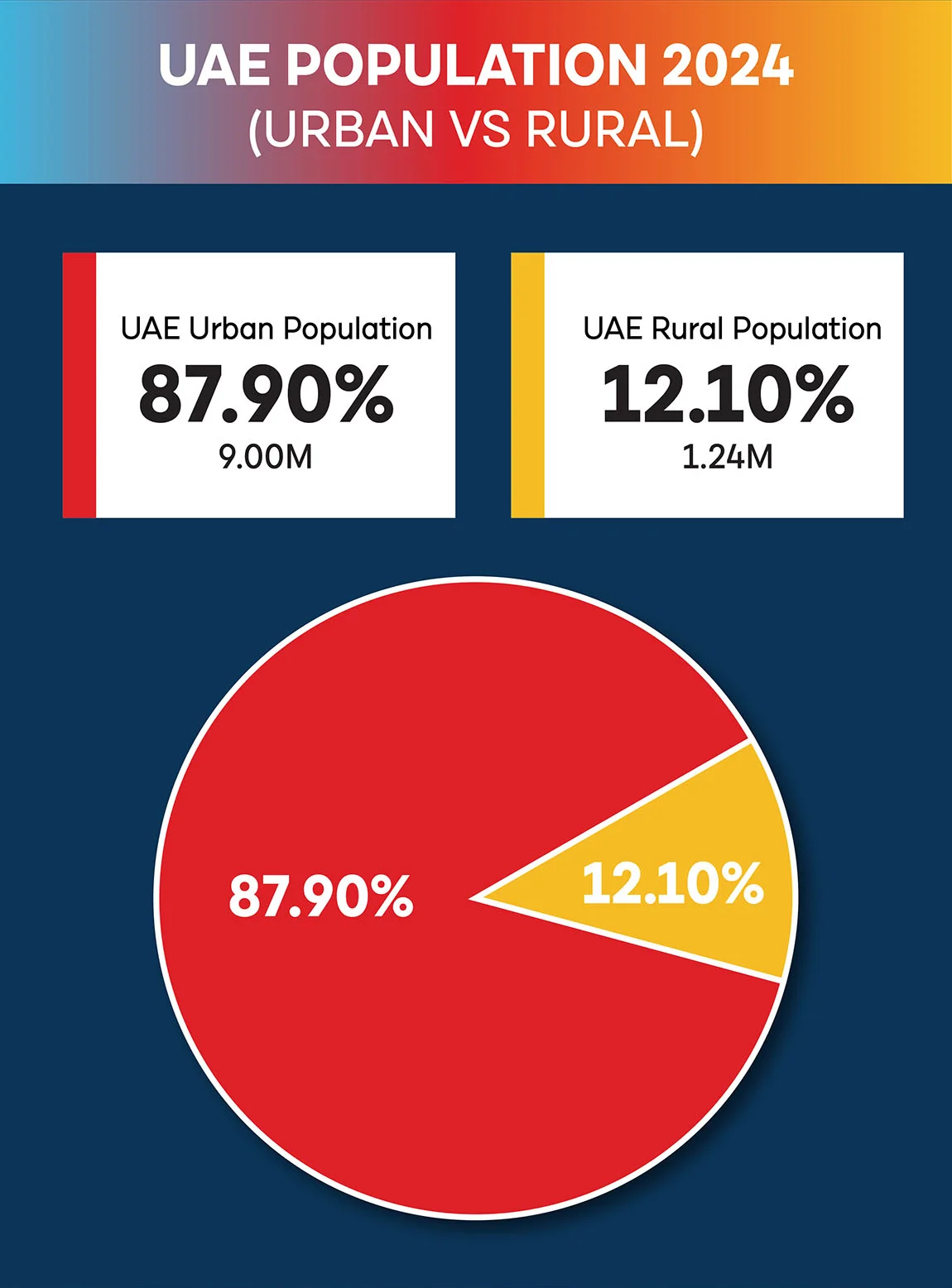
UAE Population By Year (1980 – 2024)
Year | Population | Year % Change |
2024 | 10.24 Million | 0.69% |
2023 | 10.17 Million | 0.89% |
2022 | 10.08 Million | 0.90% |
2021 | 9.99 Million | 1.01% |
2020 | 9.89 Million | 2.17% |
2019 | 9.68 Million | 1.47% |
2018 | 9.54 Million | 0.63% |
2017 | 9.48 Million | 1.28% |
2016 | 9.36 Million | 1.08% |
2015 | 9.26 Million | 8.43% |
2010 | 8.54 Million | 86.46% |
2005 | 4.58 Million | 46.33% |
2000 | 3.13 Million | 29.88% |
1995 | 2.41 Million | 32.42% |
1990 | 1.82 Million | 33.82% |
1985 | 1.36 Million | 34.65% |
1980 | 1.01 Million | 0% |
The UAE’s population story is like a journey.
In 1980, there were 1.01 million people.
By 1990, it almost doubled to 1.82 million, thanks to more jobs and a growing economy.
In the 2000s, the population skyrocketed to 4.58 million by 2005.
Big construction projects and a thriving economy brought in lots of people from around the world.
From 2015 to 2024, the population still increased, but not as fast.
Government initiatives focusing on sustainable development and managing population growth have played a role in this shift.
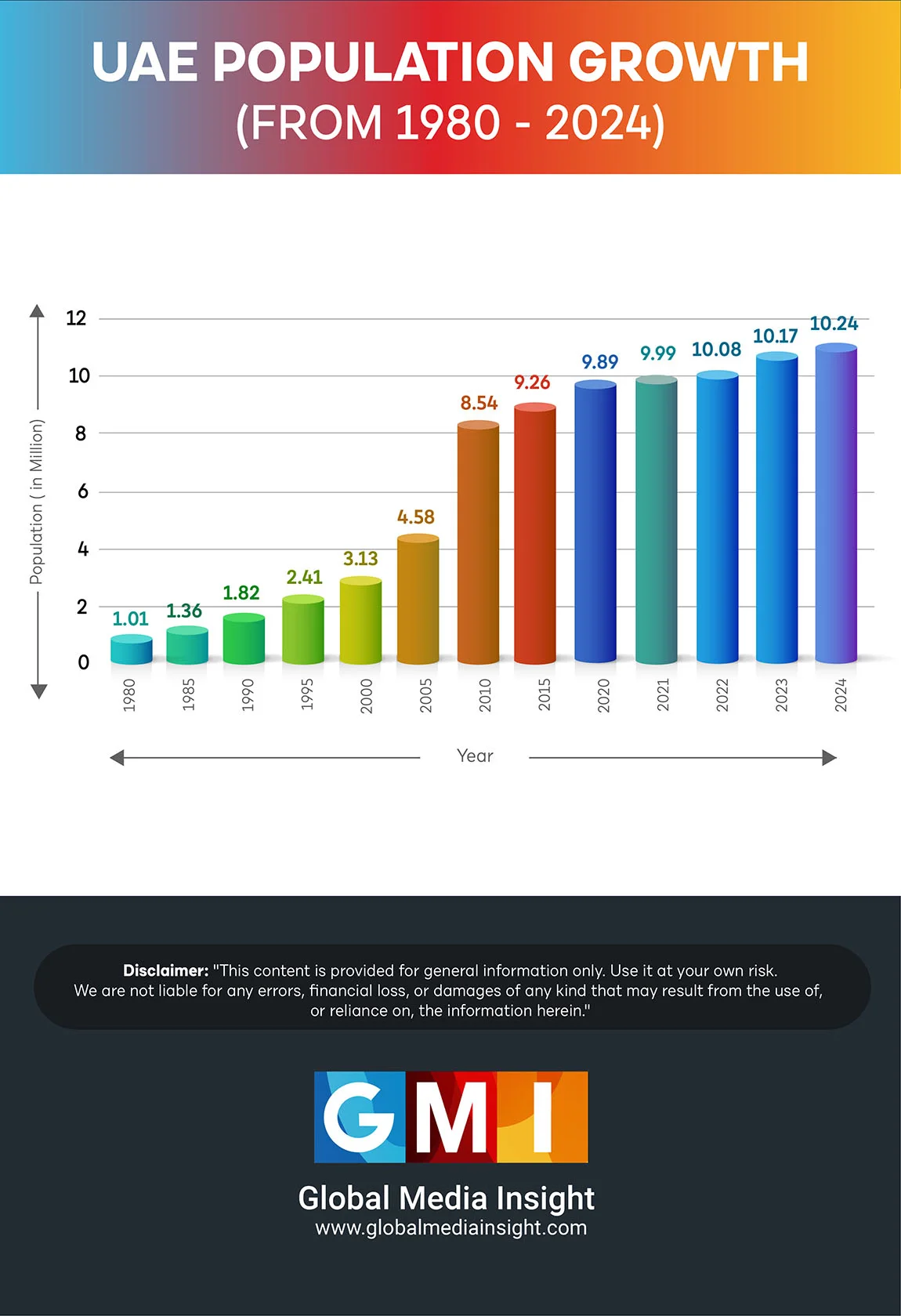
UAE Population by Religion
Although Islam is the main religion in UAE with 76.9% of people practising it, we must remember that this country is home to many expats.
So along with Muslims, we can also see Christians(9%), Hindus and Buddhists(10%), and other religions(5%) thriving here.
Literate Population of UAE
According to the latest data from the World Bank, the UAE’s literacy rate is 98%.
It was 90% in 2005 and 96% in 2019.
That means there has been a consistent growth in the literacy rate in the country thanks to the government’s socio economic policies.
One of the other more obvious reasons is that the UAE is a country of expats.
Because of the employment opportunities it offers, educated people from all over the world come and settle in the UAE.
Dubai Population in 2024
Dubai’s journey began in 1833 with around 800 settlers.
Fast forward to the 1930s, and the population had boomed to almost 20,000, steadily growing since.
Why do people love Dubai?
Well, besides its stunning beauty and welcoming atmosphere, it’s a hotspot for expatriates.
The city’s bustling economy and lots of job opportunities make it a top choice for settling down.
Now, Dubai is racing ahead as one of the fastest-growing cities globally, with a population of 3,681,463.
Surprisingly, Dubai outshines Abu Dhabi in population, even though Abu Dhabi is bigger in size.
This shows how Dubai’s charm and opportunities have made it a magnet for people from all around the world.
Note: We’re in the process of updating our infographics for 2024. In the meantime, check out our 2023 infographics for some interesting statistics!
Table of Content
- UAE Population 2023 (Key Statistics)
- The History
- United Arab Emirates – Country Profile
- Demographics of UAE in 2023
- UAE Population by Age
- UAE Population by Gender
- UAE Population by Emirates in 2023
- Emirati Vs Expatriates
- UAE Population by Nationality in 2023
- UAE Population 2023 (Urban vs Rural)
- UAE Population by Year (1980 – 2023)
- The Religious Population of the UAE
- Literate Population of UAE
- Dubai Population in 2023
- Dubai Population Growth
- Population Forecasts/Predictions
UAE Population 2023 (Key Statistics)
As of December 2023, the population of UAE is 10.17 Million, a 0.89% increase from 2022, according to the research by GMI Team.
The population density of the UAE stands at 121.59 person Km2, with most of the population residing in Abu Dhabi and Dubai.
According to the research done by GMI, the total Expat population in UAE in 2023 stands at 9.0 Million.
In 2023, the UAE’s urban population is 8.91 million, and the rural population is 1.26 million.
As of December 2023, the Indian population in UAE is 3.86 Million.
UAE Population 2023 (Infographics)

Demographics of UAE in 2023
Based on our data study, the demographic data of the UAE in 2023 can be classified into:
Gender Split
Gender | Population | Percentage |
Male | 6.97 Million | 68.58% |
Female | 3.20 Million | 31.42% |
In 2023, the gender split in the UAE continues to show a wide margin. Out of the total population of 10.17 million people, the male population makes up 68.58% i.e. 6.97 million and the female population stands at a total of 3.2 million, making up only 31.42% of the population.
This difference could be attributed to the increasing number of male expatriates in the nation’s workforce, as most of the available jobs for immigrants are dependent on male labour.
Life expectancy along with certain societal and cultural factors also influence roles and opportunities provided to each gender which has resulted in gender disparity.
A point to remember here is that these figures can vary based on region and age group.
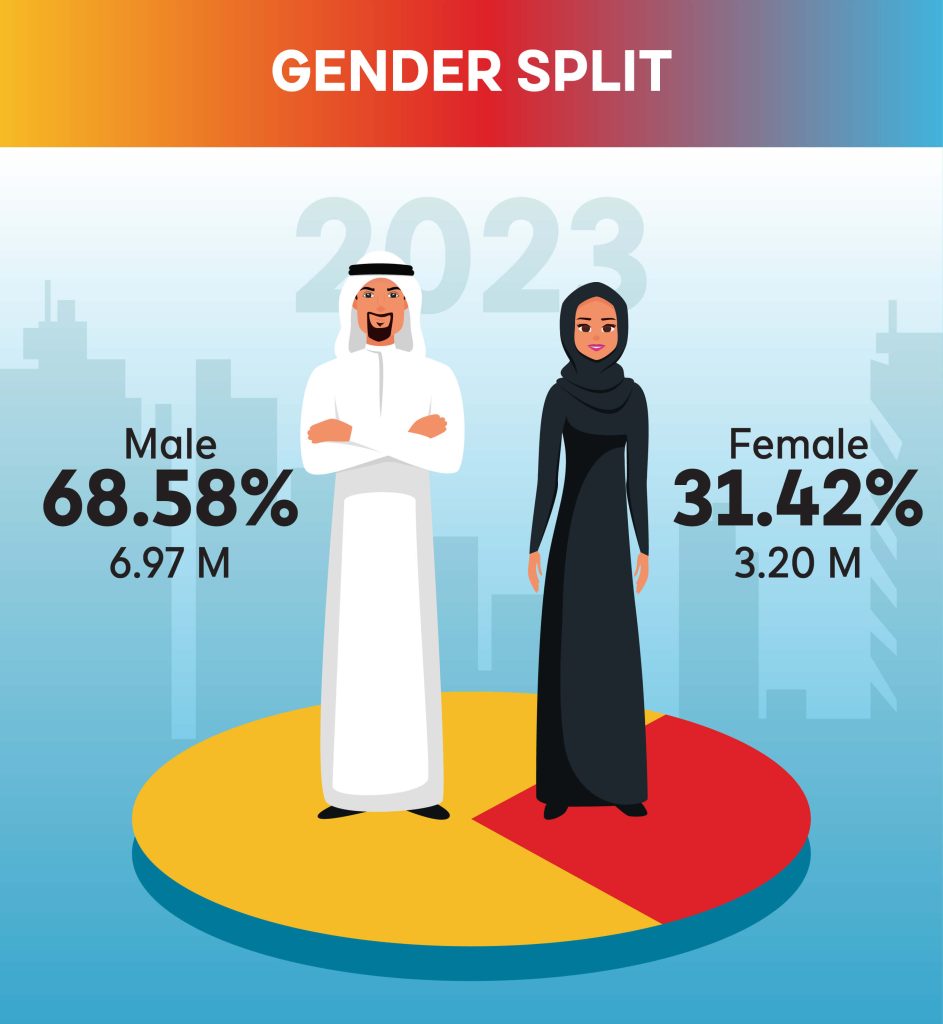
UAE Population by Age
Age Group | Population | Percentage |
0-14 years | 1.52 Million | 14.94% |
15-24 years | 1.26 Million | 12.36% |
25-54 years | 6.52 Million | 64.15% |
55-64 years | 0.67 Million | 6.59% |
65 years and over | 0.20 Million | 1.96% |
Our research shows that the death rate is extremely low, and the birth rate in the UAE is at a moderate level in 2023.
People are beginning to live longer, and the population size is increasing. This indicates a well-developed healthcare system contributing to longer life expectancy.
The immigrant population (age 25–54 years) is the highest, amounting to 6.52 million people which is significantly higher than other age groups.
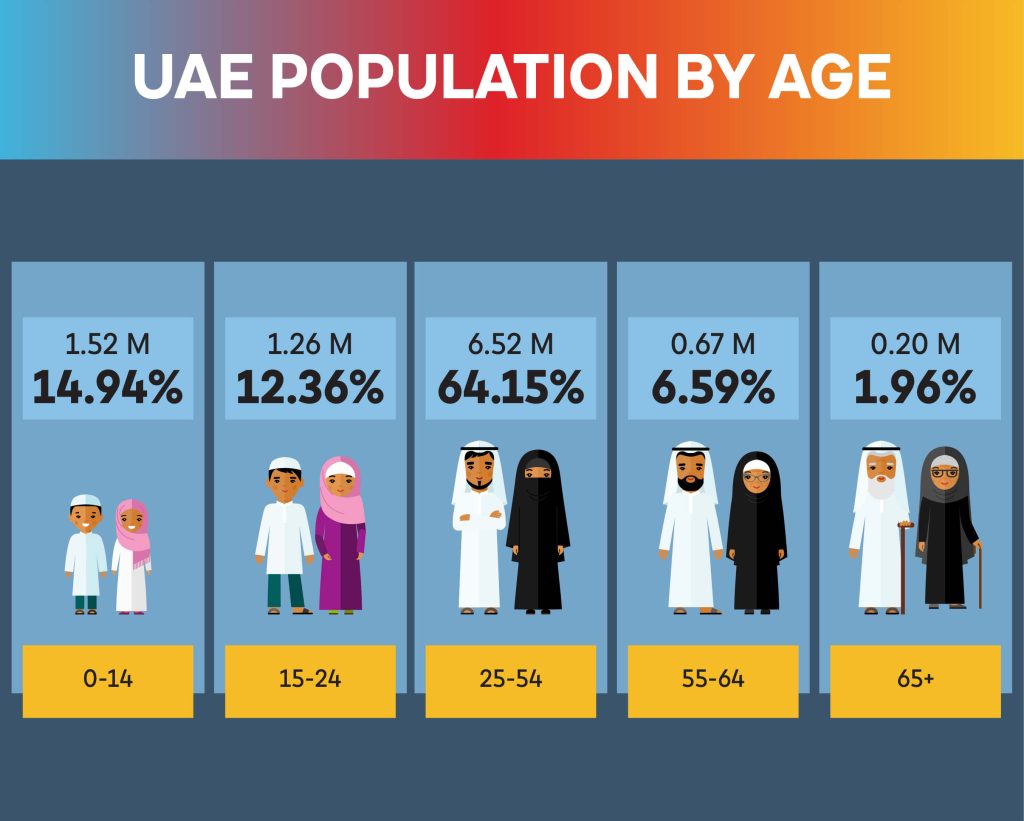
UAE Population by Gender
Age Group | Men Population | Women Population |
0-14 years | 0.77 Million | 0.75 Million |
15-24 years | 0.79 Million | 0.47 Million |
25-54 years | 4.77 Million | 1.75 Million |
55-64 years | 0.50 Million | 0.17 Million |
65 years and over | 0.14 Million | 0.06 Million |
With references to the previous statistics on gender split and age, we can analyze gender distribution in the UAE based on different age groups.
Here also we can see that the highest population of both males and females is between the ages of 25 and 54. The male population stands at 4.77 million, and the female population is at 1.75 million, showing a wide margin in gender split.
The older population of 65 years and above shows a much lower rate. The male population stands at 0.14 million, and the female population is at 0.06 million.
This indicates how the margin of difference between the male and female population is not just confined to the working age group but by small margins exists in every category.
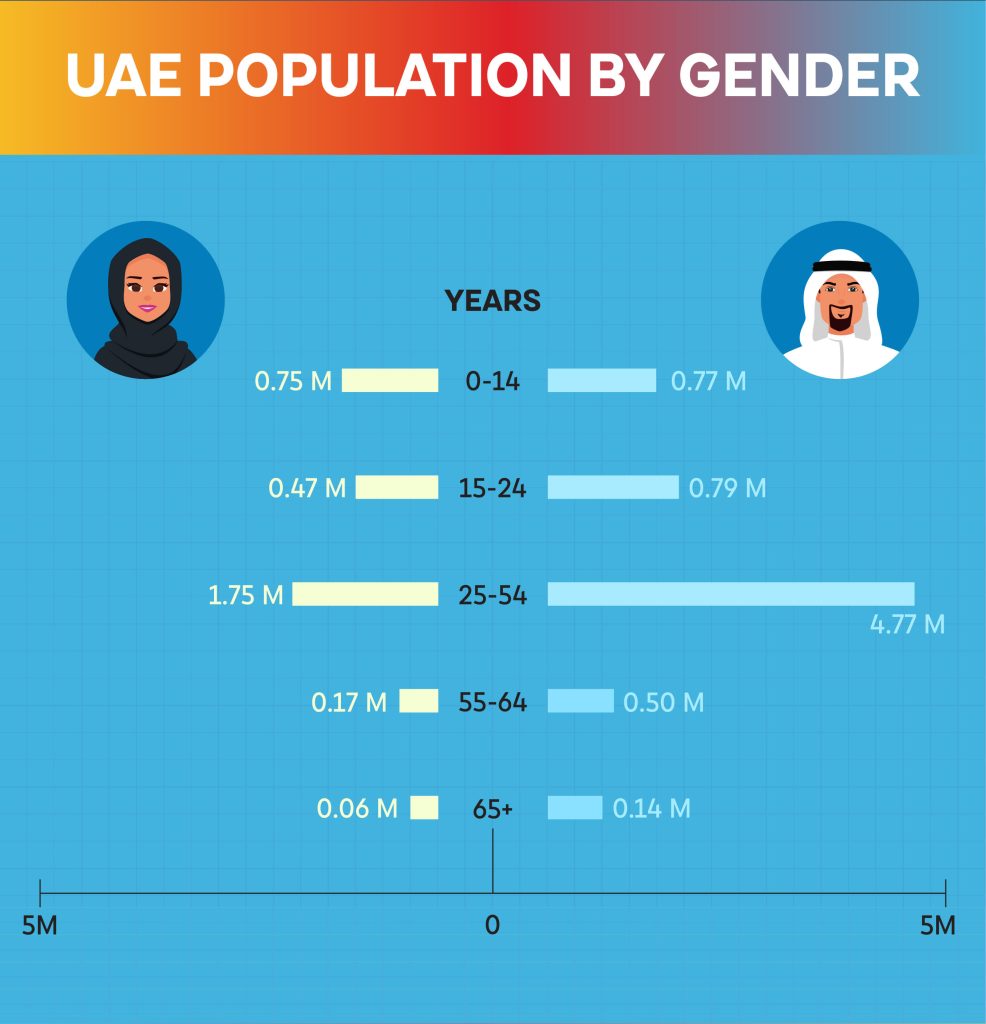
UAE Population by Emirates
Location | Population |
Dubai | 3,646,010 |
Sharjah | 1,831,000 |
Abu Dhabi | 1,567,000 |
Ajman | 504,846 |
Ras al-Khaimah | 345,000 |
Fujairah | 256,256 |
Umm Al Quwain | 49,159 |
Due to its popularity as a migration destination for Expats worldwide, Dubai has the biggest population among the seven emirates, at over 3,646,010.
Sharjah, with a population of 1,831,000, is the next largest city. The population of Abu Dhabi is 1,567,000 while that of Ajman is 504,846.
Ras al-Khaimah has 345,000 people while Fujairah has 256,256 people. Umm Al Quwain, home to 49,159 people, is the least populated Emirate.
Emirati Vs Expatriates
Nationality | Population | Percentage |
Emirati | 1.17 Million | 11.48% |
Expat | 9.0 Million | 88.52% |
The availability of job opportunities, lack of income tax, high standard of living, and other attributes make the UAE a prime destination for immigrants.
In the Expat Essential Index, the UAE stands in second place behind Bahrain.
The expat population totals around 88.52%, i.e., 9.0 million, while the nationals only amount to 11.48%, i.e., 1.17 million.
As the citizens of UAE become a minority, in 2023, the UAE cabinet seeks to bring more job opportunities for natives in all economic sectors.
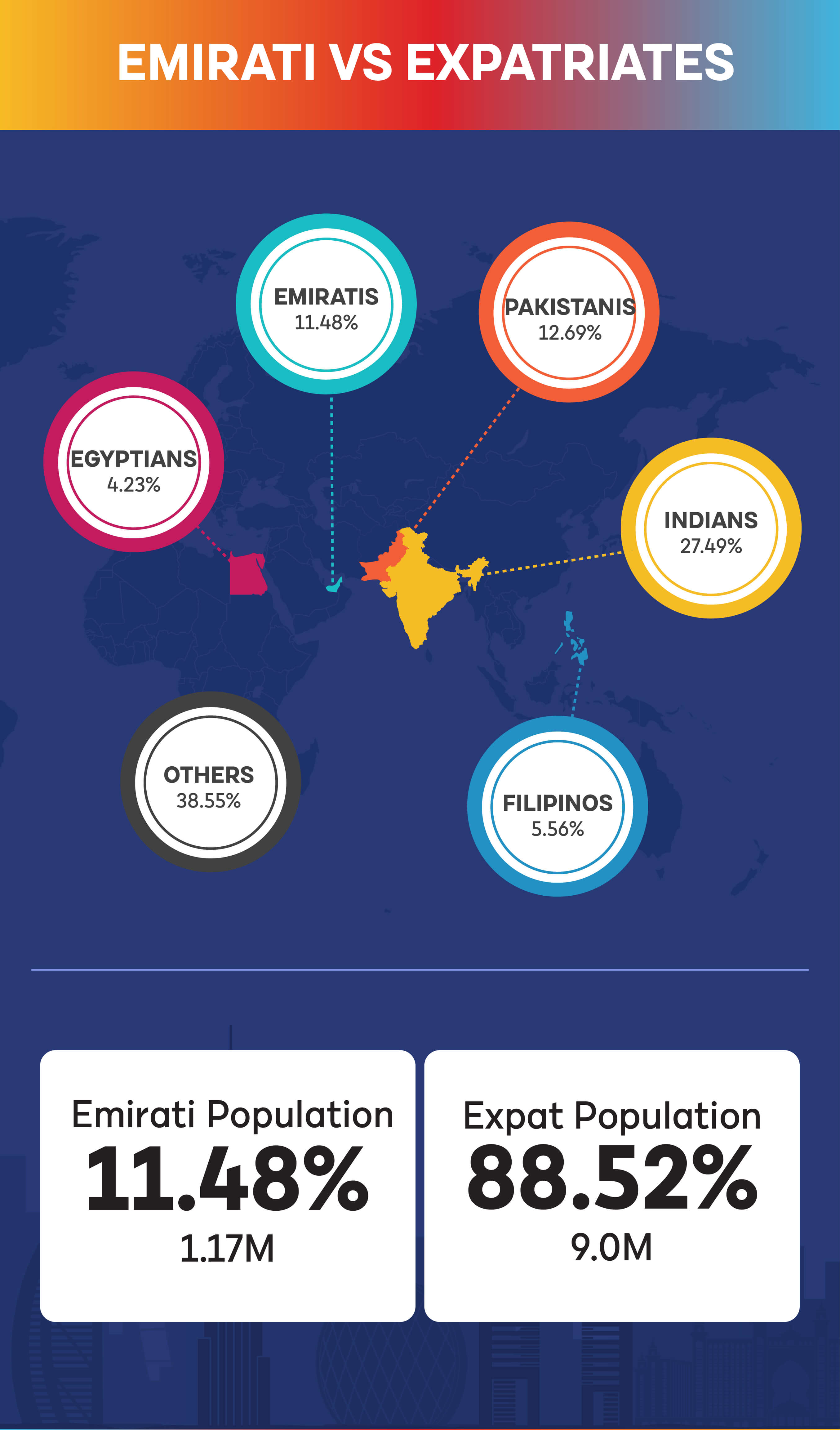
UAE Population 2023 by Nationality
Nationality | Population | Percentage |
India | 3.86 Million | 37.96% |
Pakistan | 1.70 Million | 16.72% |
Bangladesh | 0.75 Million | 7.38% |
Philippines | 0.70 Million | 6.89% |
Iran | 0.48 Million | 4.72% |
Egypt | 0.43 Million | 4.23% |
Nepal | 0.32 Million | 3.15% |
Sri Lanka | 0.32 Million | 3.15% |
China | 0.22 Million | 2.16% |
All other countries | 0.22 Million | 2.16% |
Total Expat Population | 9.0 Million | 88.52% |
When it comes to the 2023 UAE population by nationality, other than Emiratis, the majority of the population hails from Asia and Africa.
South Asians constitute the largest group among the expatriates, accounting for 70.65% of the total. Among South Asians, Indians form the largest community with 37.95% (i.e. 3.86 million), followed by Pakistanis and Bangladeshis with 16.72% (i.e., 1.70 million) and 7.38% (i.e. 0.75 million) respectively.
Southeast Asian countries like the Philippines also have a significant presence, contributing 6.89% (i.e., 0.70 million) to the UAE’s expat population.
West Asian nationals, particularly Iranians, make up 4.72% of the expat population. East Asian countries, such as China, contribute around 2.16% to the UAE’s expat population.
From Africa, Egypt is the major contributor to the UAE’s population with 4.23%
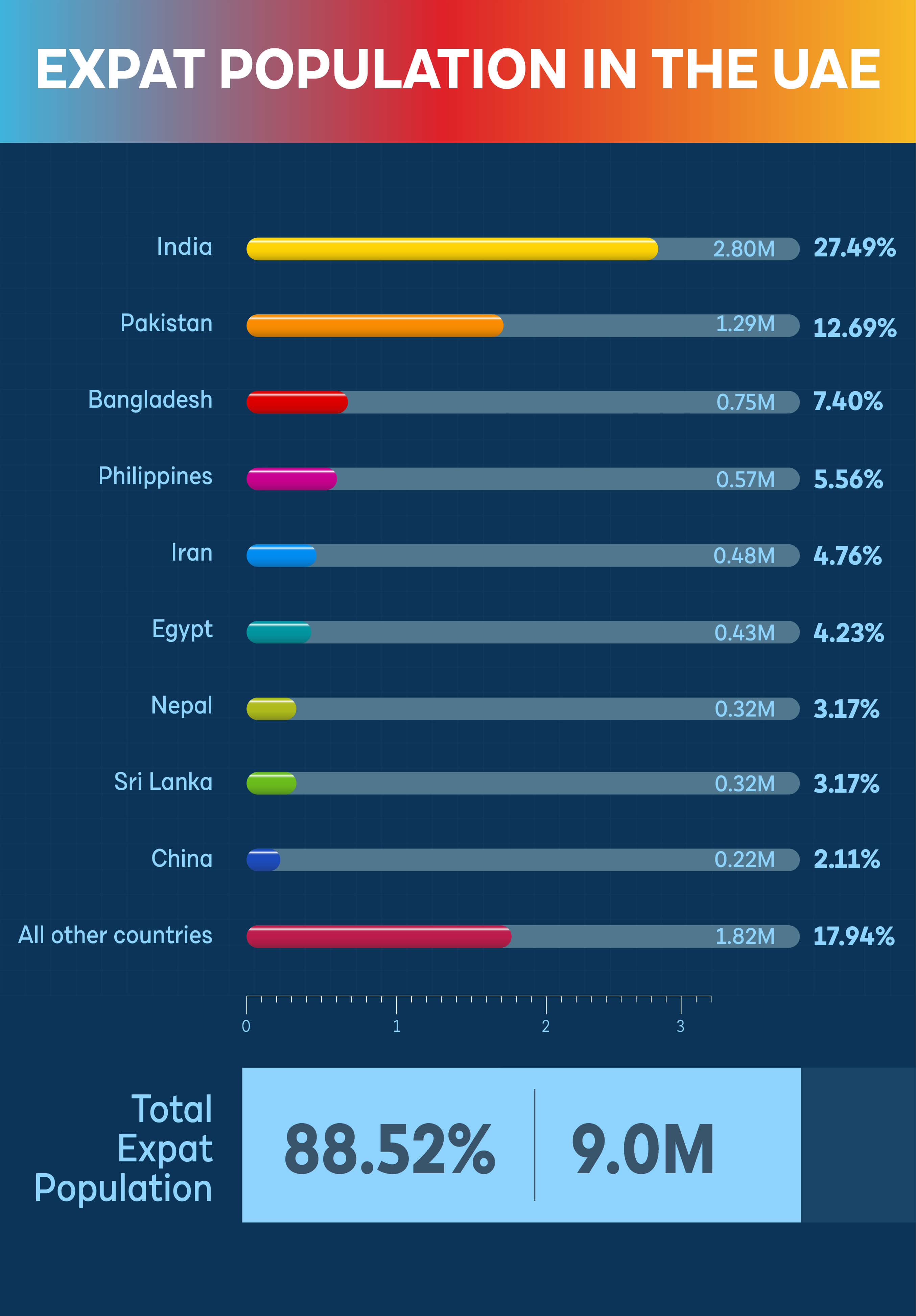
UAE Population 2023 (Urban vs Rural)
Our UAE population data study shows that the UAE has been experiencing urbanization trends for quite some time.
In 2023, the urban population reached 8.91 million, accounting for 87.6% of the total population, a slight increase from 2022.
In contrast, the rural population in 2023 stands at 1.26 million, constituting 12.4% of the total population, a slight decrease from 2022.
This shift towards urbanization may be attributed to an increasing number of people migrating to cities in search of job opportunities and better living conditions.
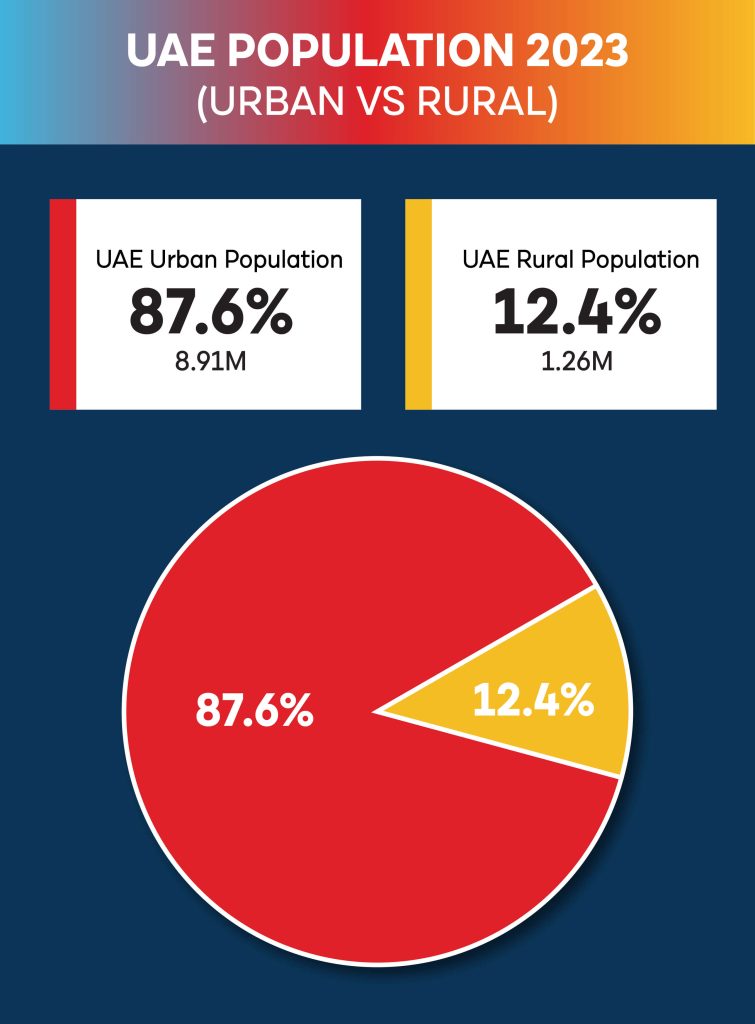
UAE Population By Year (1980 – 2023)
Year | Population | Year % Change |
2023 | 10.17 Million | 0.89% |
2022 | 10.08 Million | 0.90% |
2021 | 9.99 Million | 1.01% |
2020 | 9.89 Million | 2.17% |
2019 | 9.68 Million | 1.47% |
2018 | 9.54 Million | 0.63% |
2017 | 9.48 Million | 1.28% |
2016 | 9.36 Million | 1.08% |
2015 | 9.26 Million | 8.43% |
2010 | 8.54 Million | 86.46% |
2005 | 4.58 Million | 46.33% |
2000 | 3.13 Million | 29.88% |
1995 | 2.41 Million | 32.42% |
1990 | 1.82 Million | 33.82% |
1985 | 1.36 Million | 34.65% |
1980 | 1.01 Million | 0% |
Dubai Population in 2023
Dubai is the first choice for immigrants considering the growing economy and diverse opportunities. It has a rich culture, natural beauty and is the business hub of the Middle East.
Therefore as mentioned above it is the most populated Emirate in the UAE. As of December 2023, the population of Dubai stands at 3,646,010.
The population density of the city is approximately 762.6 individuals per square meter. Dubai is the second largest Emirate with an area of 4,114 square kilometres.
Being a cosmopolitan city, the city has seen the growth of many religions including Christians, Sikhs and Hindus.
Dubai Population Growth
In 1980 the population of Dubai was around 0.27 million. This increased to 0.68 million in 1995 and 1.3 million in 2005.
In 2015, it crossed the two million mark to reach 2.38 million and by 2018 it again added 1 million to its population. The population growth rate is predicted to be 10.7% annually.
Just like the rest of the emirates, the gender division is skewed here. There are 7,118,367 million males and 3,128,568 million females.
There are several factors for the high population growth rate in Dubai, the most important of them all is the cosmopolitan approach.
Due to this many foreign nationals have settled in the region increasing the expatriate population. In 30 years, the population has grown by millions.
The Dubai Expo 2020 has created almost 2,70,000 additional job opportunities. With the huge influx of workers, Dubai’s population will hit an all-time high in 2030.
Population Forecasts/Predictions
According to reports, the population boom of the UAE is supposed to reach its full peak in 2033 at 10.71 million people.
There is a net increase of 1 person every minute.
Researchers claim that once the peak is reached, the population will then decline very slowly and by the end of the 21st century, the total population will be 9.03 million people.
The growth rate of 1.47% is expected to decrease to 0.68% in 2025.
These same sets of projections state the population of the United Arab Emirates will be 11,054,579 in 2030, 12,207,333 in 2040 and 13,163,548 in 2050.
*Note: These population estimates have utilized the data from World Population Prospects(UN).
The steady growth of the population in the UAE indicates that the economy is well-developed to nourish and sustain the influx of people looking to live here.
With an interesting mix of nationalities, UAE has emerged as a global power with tremendous reach in 2023.
Check out our blog on the UAE Population Statistics 2022
UAE Population Statistics 2021
UAE Population 2021 (Top Picks)
- The UAE’s population in 2024 stands at 10.24 million.
- UAE Population in 2021 was 9.99 Million according to the data provided by the United Nations.
- The Population Density in the United Arab Emirates is 118 per square kilometer.
- The Total Expat Population of UAE in 2021 is 8.84 million.
- Dubai Population in 2021 was 3.43 Million according to official Dubai Government website.
UAE Population Statistics 2021 : Infographics

UAE Population Statistics by Year (Historical Population)
| Year | Population |
| 2021 | 9.99 Million |
| 2020 | 9.89 million |
| 2019 | 9.77 million |
| 2018 | 9.54 million |
| 2017 | 9.40 million |
| 2016 | 9.27 million |
| 2015 | 9.15 million |
| 2014 | 9.07 million |
| 2013 | 9.0 million |
| 2012 | 8.90 million |
| 2011 | 8.67 million |
| 2010 | 8.27 million |
Demographics of UAE in 2021
Considering the demographics of the UAE population, the nationals make up a mere 11%, while expatriates 89%. The current net migration rate is 1.93 per 1000 population. The population is heavily concentrated in the northeast region of the country, where the three largest Emirates – Abu Dhabi, Dubai, and Sharjah – are located. The area alone is home to 75% of the population.
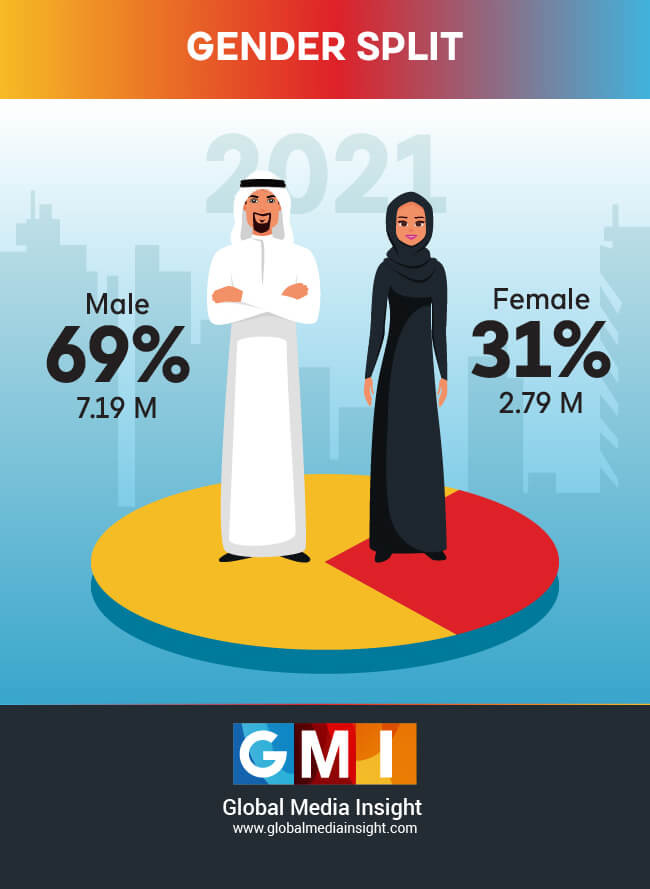
With 69% males and 31% females, the UAE has not yet achieved gender parity. This is visible across all age groups. With more expatriates, the majority of the UAE population (66.35%) falls into the 25-54 age bracket.
According to recent statistics, the birth rate of the UAE is 10.110 births per 1000 people, and the death rate is approximately 2 deaths/1,000 population. The total fertility rate (TFR) in the country is registered at 1.73 live births per woman. The infant mortality rate is 5.3 deaths/1,000 live births while the average life expectancy is 79 years.
UAE Population by Age
| Age Group | Population | Percentage |
| 0-14 | 1.4 Million | 14.95% |
| 15-24 | 1.1 Million | 11.80% |
| 25-54 | 6.6 Million | 66.35% |
| 55-64 | 0.5 Million | 5.80% |
| 65+ | 0.1 Million | 1.10% |
The median age is approximately 30.3 years. The population of children between 0 and 14 years is 1.4 million. The age group of 15-24 constitutes 1.1 million of the population, while the age groups 25-54 and 55-64 constitute 6.6 million and 0.5 million respectively. The country has 0.1 million people above the age of 65.
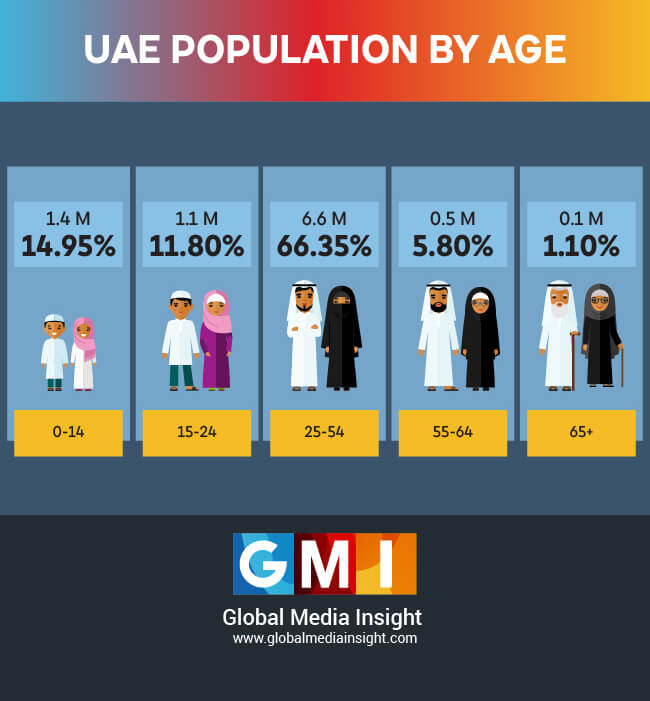
UAE Population by Gender
| Age Group | Women | Men | Total |
| 0-14 years | 0.73 million | 0.76 million | 1.49 million |
| 15-24 years | 0.43 million | 0.74 million | 1.17 million |
| 25-54 years | 1.75 million | 4.85 million | 6.60 million |
| 55-64 years | 0.14 million | 0.44 million | 0.58 million |
| 65 years and over | 0.04 million | 0.07 million | 0.11 million |
The 2021 UAE gender ratio is quite interesting to note. Men dominate the chart across all age groups. In the 25-54 years group, males outnumber females by 3.1 million. This can be attributed to the whopping expat population. Of the 1.4 million under-14 kids, males make up 0.76 million and females, 0.73 million. Similarly, between 15 and 24 years, there are 0.74 males and 0.43 females. While the number of men in the 55-64 age group is 0.44 million, the number of women stands at 0.14 million. Currently, in the UAE, there are 0.07 million men and 0.04 million women in the 65+ range.
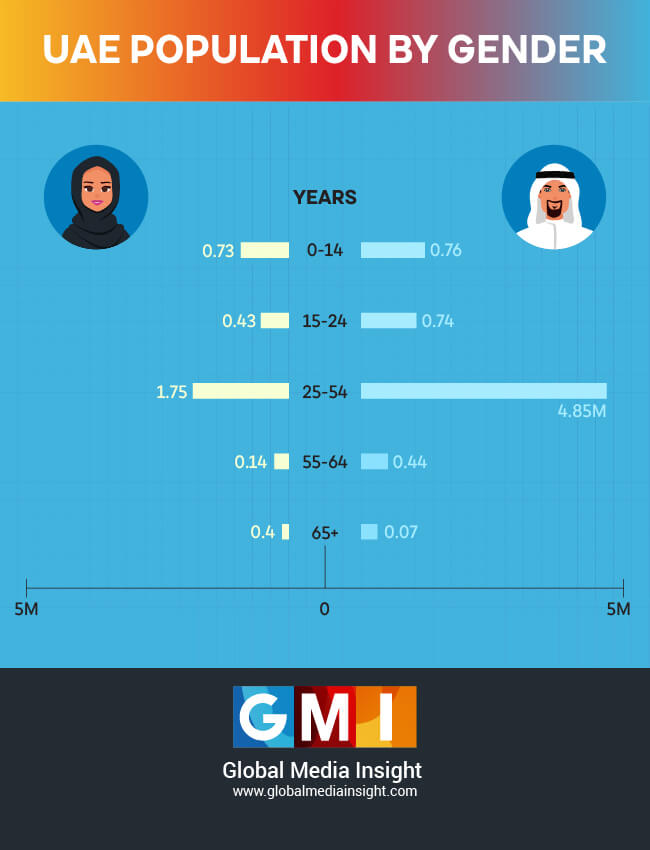
UAE Population – Adult vs Minor
The 2021 UAE population stats show that 82.58% (8.24 million) are adults and 17.42% (1.75 million) are minors.
UAE Population 2021 by Emirates
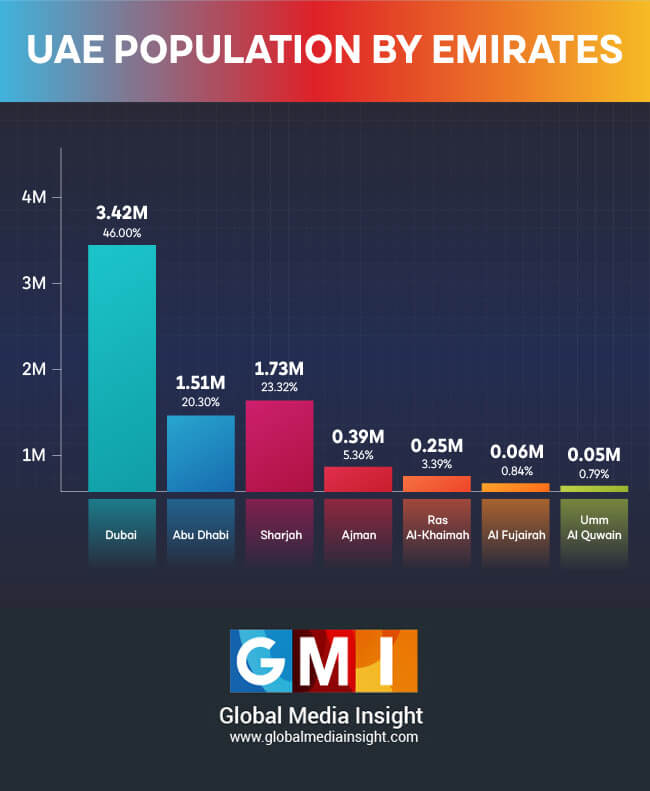
Most Popular Social Media Platforms in the UAE in 2021
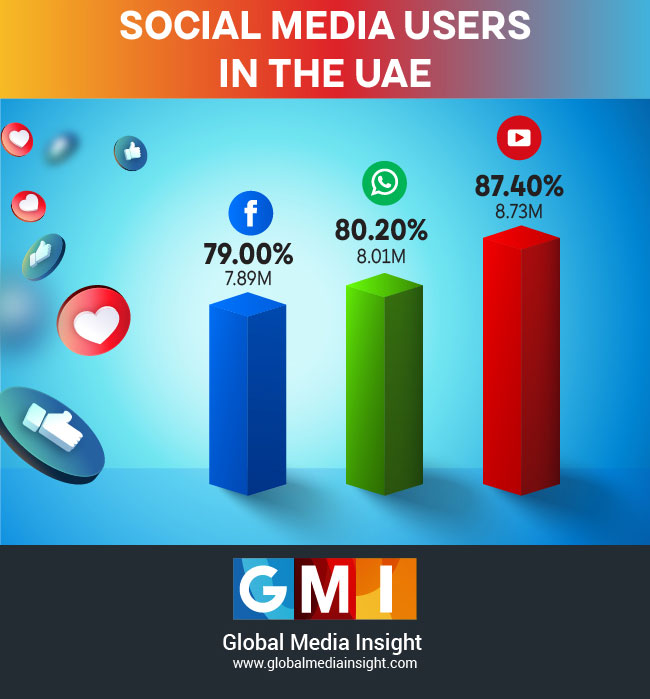
Dubai Population 2021
Today, in 2024, the population in Dubai stands at 3.68 Million and the population was 3.43 million in 2021. From 2.56 million in 2016 the population has grown by over 1 million in just eight years.
Dubai is the second-largest emirate in the country with an area of 4,114 sq. km. Located in the southwest corner of the Arabian Gulf, it is hailed as a global business hub and the commercial capital of the UAE. This cosmopolitan metropolis has more expatriates than Emiratis. Though the local population is Muslim, there are Christian, Hindu and Sikh communities.
In 1980, the population of Dubai was roughly 0.27 million. The number rose to 0.68 million in 1995, and 1.3 million in 2005. In 2015, the population crossed the two million mark to reach 2.38 million. In 2018, it again crossed 3 million.
UAE POPULATION STATISTICS 2018 : INFOGRAPHIC

The UAE’s population in 2024 stands at 10.24 million.
In 2018, the population was 9.543 million. Other sources which confirm this estimate include populationpyramid.com and uae-expatriates.com, while Facebook Insights reveal that the potential reach of the platform in the UAE in the third quarter of 2017 was 9.3 million. We can safely assume that the population of the UAE in 2018 stands at around 9.54 million.
The Federal Competitiveness and Statistics Authority (FCSA) had published the that UAE population according to administrative records until 31 December 2016 was 9,121,167 (9.12 million).
FSCA is a government-backed agency formed to improve UAE’s data and competitiveness capabilities. FCSA claims that the population figures for 2016 are highly accurate and up-to-date. The population figures were derived with the support and collaboration of several national partners and other stakeholders.
The last official census of UAE was conducted in the year 2005, with the population numbers pegged at 4.1 million. The official UAE government website announced that the population stood at 4.8 million in 2008, which indicates that there has been a double-fold increase in the population in a span of 10 years.
Male vs Female Population of the UAE in 2018
According to our research, in 2018, males make up 72% of the UAE population at 6.89 million while the number of females account for only 28% of the total UAE population at 2.65 million. That makes the gender split at 72% male – 28% female.
Men outnumber women in all age groups as mentioned in the above infographic. However, the number of males and females in age group 0 to 14 are almost equal.
The number of men under the age group 15 to 24 is double that of women in the same age group. The most significant difference, gender-wise, is seen in age group 25 to 54. There are 4.83 million men within this age group in the UAE whereas the number of women within this age group is just 1.46 million.
Demographics of the United Arab Emirates
The life expectancy in the UAE has been on a steady rise. The majority of the population falls into the 25-54 age bracket, again indicating that immigrants and expats make up a large chunk of UAE’s population.
Age-wise population of the UAE
Majority of the UAE population falls in the age group of 25 to 54 years. A large part of this can be attributed to the expatriate population of working men and women who fall in this age category.
The median age for Dubai is 33.5 years.
Expatriate Population of the UAE in 2018
As stated previously in this article, expatriates and immigrants account for 88.52%. Emiratis make up remaining 11.48% of the population.
South Asians, which include people from India, Bangladesh, Pakistan and other South Asian nations, compose 59.48% of the population. The rest of population comprises of Egyptians at 4.23% and others at 17.94%. The UAE government’s population strategy envisions in making the Emiratis the majority community or at least bringing the numbers up to 40% by the year 2021.
Digitization and Economic Status of the UAE
The UAE features among the top “adopter” economies in terms of connectivity within the Arab world according to Huawei’s Global Connectivity Index (GCI) 2017. The report analyzed 50 countries, of which 16 were considered as front-runners, 21 as adopters, while the remaining 13 as starters.
Front-runners mostly comprise of developed nations, Adopters have an average GDP per capita of $15,000 and starters are countries with an average GDP capita of $3,000. Adopters focused on increasing ICT demand and working towards digitization and economic growth.
Most popular Social Media Platforms in the UAE 2018
Facebook is the most popular social media in the UAE with 97.48% of population using the social media platform.
WhatsApp is the most popular messenger app in the UAE with 97% of people in UAE using WhatsApp.
YouTube users in the UAE have also increased compared to previous year. According to Adwords insights, 80.92% of the UAE population (7.72 million) uses YouTube.
Emirate-wise Population
Nearly 75% of the population of UAE is concentrated on the northeast of the country. The two biggest cities Dubai and Abu Dhabi have more than 3 million residents each. Dubai, with the busiest port in the region, is the commercial capital of the country. Some of the biggest companies in the world have their headquarters in the city.
Abu Dhabi is the capital of the country. The city houses federal government offices and serves as the seat of the UAE Government. Nearly 95% of the oil and 92% of the gas in the country are in this Emirate, making it the wealthiest Emirate. When considering other entries in the list of city wise population distribution of UAE, Sharjah emerges a distant third from the big two with 1.51 million people. Sharjah’s close proximity to Dubai and much lower living costs can be attributed as reasons for its growth.
How We Arrived At These Figures
The emirate-wise population mentioned here is projected from the last known official population figures released by the UAE government. Several other factors, including the historical population growth rate available from official records as well as events in these emirates which might influence the observed population growth were taken into account before arriving at the final population of each emirate.
The UAE government has conducted 4 censuses since the very first one 1980. when the last census was done in 2005, Abu Dhabi was the emirate with the most population. Since then, Dubai has grown rapidly to become the most populated city in UAE. This is reflected in the latest estimates by the UAE government. The government arrives at these population figures from the citizen and immigration records that it maintains.
Refer below graphs to compare the population change in each emirate.
The Population Boom
Over the years, the country has gone through several key demographic changes. The discovery of oil gave momentum to the economy of the country. Recently, the UAE government has also been promoting a tourism and knowledge-based economy to spur the economic momentum. Today, Dubai ranks among the most visited cities of the world, ranking 6th with 16 million visitors in 2017, as per thisisinsider.com.
According to recruitment agencies, diversification of the UAE’s economy has led to a boom in the number of specialist jobs. With the rise of new establishments and businesses in the UAE, job opportunities are created for talented professionals in various fields including medicine and healthcare, tourism and hospitality, information technology, artificial intelligence, education, digital marketing, SEO, ecommerce, web design and web development, to name a few.
The increase in the number of jobs across sectors led to an influx of workers at all levels of all nationalities. Within a span of a decade, the total population grew by about 5 million. This boom in population was largely due to the burgeoning expat and immigrant population. UAE has the world’s highest net migration rate, with nearly 88.52% of population composed of expatriates and immigrants.
This becomes even more apparent when we look at the fertility rate in the UAE. The average rate of babies born per fertile woman has been showing a downward trend for the past decade, and yet the population is soaring.
An in-depth analysis of the population of the UAE can help marketers formulate plans, goals and strategies to promote their brand. With more than 22 years of experience in the digital landscape of the Middle East, GMI has crafted the digital presence of some of the best brands in the region. We understand what it takes to tap into your target audience on various digital platforms. We can help ideate and weave a digital strategy that works for your brand. Talk to our digital strategists today and take your brand to the people you want to reach.
Disclaimer: GMI acknowledges that though we try to report accurately, we cannot verify the absolute facts of everything that has been represented on this infographic. The information represented is based on information researched from various sources on the internet. We are not liable for any errors, financial loss, or damages of any kind that may result from the use of, or reliance on, the information herein.









